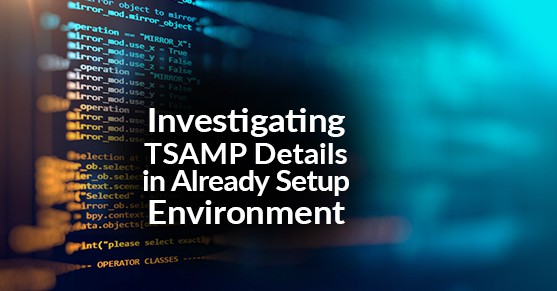There are several scenarios where you might need details to re-build TSAMP. If TSAMP did not start properly after an upgrade or even while troubleshooting, the option to open a case with IBM and get root cause analyzed takes time. In many of these scenarios, it’s just better to rebuild TSAMP from scratch. As a standard practice, our team keeps these details handy, if there is a situation in which we need to re-build TSAMP.
You will need the following details to setup TSAMP:
- Server Long Name
- Server Short Name
- Server Identifier for HADR
- Network Interfaces for Public Network
- Virtual IP (VIP)
- TSAMP Domain
- Quorum Device
Server Long Name
You can get this using the hostname -a command
Server Short Name
You can get this using the hostname command, or you can also look for this information in /etc/hosts
Server Identifier for HADR
Make sure that the primary and standby node names are mapped to their corresponding public IP addresses in the /etc/hosts file:
192.XX.2.XX linux01 linux01.example.com
192.XX.2.XX linux02 linux02.example.com
Network Interfaces for Public Network:
The bond0 (or whatever is applicable in your case) network interfaces are connected to each other through the external network cloud forming the public network.
bond0 Link encap:Ethernet HWaddr E0:DB:55:1F:9A:0E
inet addr:10.100.XX.XX Bcast:10.XXX.XX.XXX Mask:255.XXX.255.0
inet6 addr: fe80::e2db:55ff:fe1f:9a0e/64 Scope:Link
UP BROADCAST RUNNING MASTER MULTICAST MTU:1500 Metric:1
RX packets:2328296868053 errors:1 dropped:16 overruns:0 frame:6826
TX packets:1798754444501 errors:0 dropped:0 overruns:0 carrier:0
collisions:0 txqueuelen:0
RX bytes:576587636036994 (524.4 TiB) TX bytes:1473974292907023 (1.3 PiB)
Note the server IP associated with the network interface
Virtual IP (VIP)
$ db2pd -ha
DB2 HA Status
Instance Information:
Instance Name = db2inst1
Number Of Domains = 1
Number Of RGs for instance = 2
Domain Information:
Domain Name = xtvprod
Cluster Version = 3.2.1.2
Cluster State = Online
Number of nodes = 2
Node Information:
Node Name State
--------------------- -------------------
pr1db02 Online
pr1db01 Online
Resource Group Information:
Resource Group Name = db2_db2inst1_db2inst1_DB2XTVDB-rg
Resource Group LockState = Unlocked
Resource Group OpState = Online
Resource Group Nominal OpState = Online
Number of Group Resources = 2
Number of Allowed Nodes = 2
Allowed Nodes
-------------
pr1db01
pr1db02
Member Resource Information:
Resource Name = db2ip_192_0_XX_XX-rs
Resource State = Online
Resource Type = IP
Resource Name = db2_db2inst1_db2inst1_DB2XTVDB-rs
Resource State = Online
Resource Type = HADR
HADR Primary Instance = db2inst1
HADR Secondary Instance = db2inst1
HADR DB Name = XTVDB
HADR Primary Node = pr1db01
HADR Secondary Node = pr1db02
Resource Group Name = linux01 _0-rg
Resource Group LockState = Unlocked
Resource Group OpState = Online
Resource Group Nominal OpState = Online
Number of Group Resources = 1
Number of Allowed Nodes = 1
Allowed Nodes
-------------
pr1db01
Member Resource Information:
Resource Name = linux01_0-rs
Resource State = Online
Resource Type = DB2 Member
DB2 Member Number = 0
Number of Allowed Nodes = 1
Allowed Nodes
-------------
pr1db01
Network Information:
Network Name Number of Adapters
----------------------- ------------------
db2_public_network_0 2
Node Name Adapter Name
----------------------- ------------------
linux01.example.com bond0
linux02.example.com bond0
Quorum Information:
Quorum Name Quorum State
------------------------------------ --------------------
db2_Quorum_Network_192_0_XXX_X:6_X_48 Online
TSAMP Domain
You can find the TSAMP Domain name using the following command. The Domain name is in the below example:
[db2inst1@db2prod01 ~]$ lsrpdomain
Name OpState RSCTActiveVersion MixedVersions TSPort GSPort
xtvprod Online 3.1.2.2 Yes 12347 12348Quorum Device
To find the Quorum Device, use the following command. Quorum Device is in the below example (192.0 .XX.123)
[db2inst1@db2prod01 ~]$ lsrsrc -c -Ab IBM.PeerNode
Resource Class Persistent and Dynamic Attributes for IBM.PeerNode
resource 1:
CommittedRSCTVersion = ""
ActiveVersionChanging = 0
OpQuorumOverride = 0
CritRsrcProtMethod = 1
OpQuorumTieBreaker =
"db2_Quorum_Network_192_0_XX_123:12_12_23"
QuorumType = 0
QuorumGroupName = ""
Fanout = 32
OpFenceGroup = ""
NodeCleanupCommand = ""
NodeCleanupCriteria = ""
QuorumLessStartupTimeout = 120
CriticalMode = 1
NotifyQuorumChangedCommand = ""
NamePolicy = 0
Other ways of saving TSAMP information:
To capture: root@server # sampolicy –s hadr_policy_YYYYMMDD.xml
To apply: root@server # sampolicy –a hadr_policy_YYYYMMDD.xml
Note that using this method may not catch the configuration that needs to be done within Db2.
In 11.1 and higher, you can also use the -o option on the db2haicu command to export the current TSAMP configuration to an XML output file.
Useful tech notes to read:

